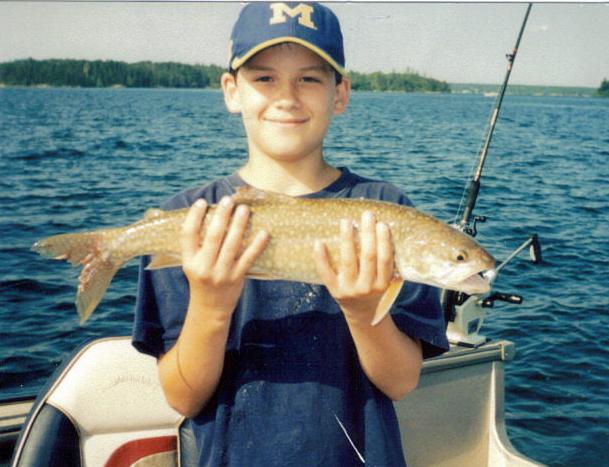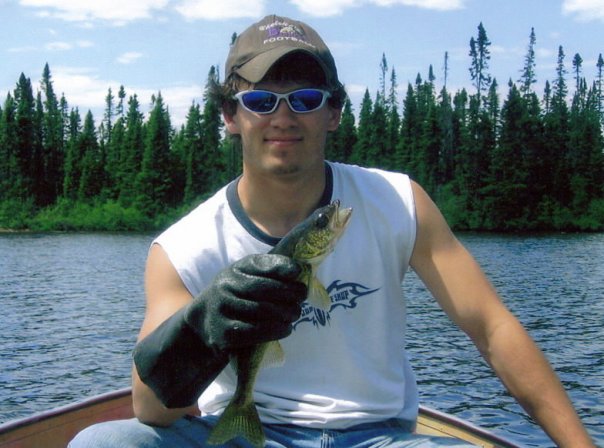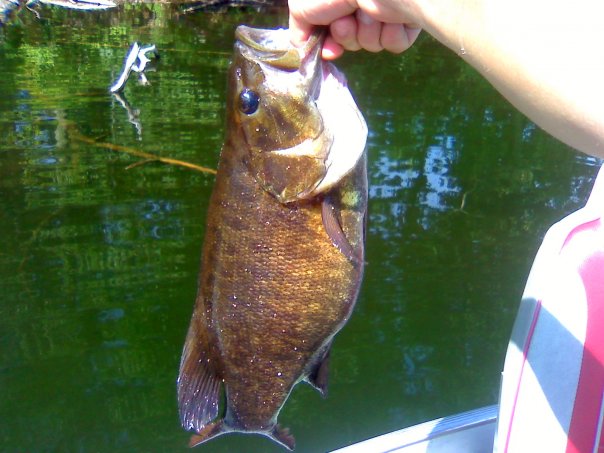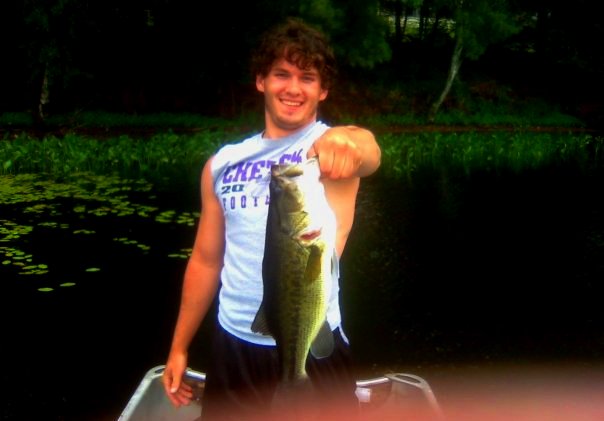SMALLMOUTH BASS
(Micropterus dolomieui)
Dustin Hetke
BIO 203: Organismal Biology, UW-La Crosse
Habitat range & characteristics
Water quality, food availability, and the presence or absence of competing species are among the most important variables that dictate the degree to which a freshwater environment qualifies as suitable habitat for smallmouth bass. Hypothetically, the ideal habitat for these fish would boast a rich and plentiful supply of forage; ample locations that offer the space, safety, and geologic elements necessary to carry out a successful spawning period; clear to lightly-stained water that allows the smallmouth bass to maximize its vision as an advantage in hunting prey; relatively cool water temperatures that promote sufficient levels of dissolved oxygen; and the virtual absence of competing fish populations that require similar conditions for their own species to survive. Of course, a natural freshwater ecosystem that meets all of these criteria is extremely rare. Therefore, while the smallmouth bass would surely flourish under these conditions, its lifestyle has been adapted for general success in a variety of less-than-optimum habitats. In reality, the smallmouth bass must make the most out of the resources at its disposal. Those lakes, rivers, and reservoirs that offer the best overall combination of the aforementioned criteria, all within a relatively close range to each other, are most likely to have smallmouth bass inhabiting them. Generally, smallmouth bass are not present in habitats that require them to travel long distances to find and utilize resources, even if all of them are present. If a competing species, such as walleye or largemouth bass, has exercised dominance over the best areas to feed or spawn, the smallmouth often has no choice but to settle for the next-best options. In this way, and contrary to popular belief, smallmouth habitat is defined less by preference than one might assume.
Prior to human interference, the prevalence of
smallmouth bass was almost exclusively limited to the mid-north to
northeastern quadrant of what is now the continental United States: east
to west from Minnesota to the edge of Vermont, and north to south from
parts of Canada to portions of Arkansas and Alabama. In general,
its native range primarily included the Great Lakes; the upper
Mississippi, St. Lawrence, Ohio, and Tennessee Rivers; and the
extensively branched drainage systems associated with these water
bodies. Since the arrival of American settlers, this species has
become extensively introduced in lakes, rivers, and reservoirs
throughout North America. The expansion of smallmouth bass ran largely
parallel with the construction of railroads in the 1800s, by which these
fish were first shipped to various locations across the nation.
While the aforementioned areas remain home for the majority of
smallmouth bass, widespread introduction of smallmouth bass into new
bodies of water has extended its distribution greatly via human stocking
efforts. As of today, successful smallmouth bass fisheries exist
in almost every U.S. state, although they remain few and far between in
the western and southernmost areas of the country. Attempts
have been made to introduce self-sustaining populations in Europe and
Africa as well, but results have been mixed at best.
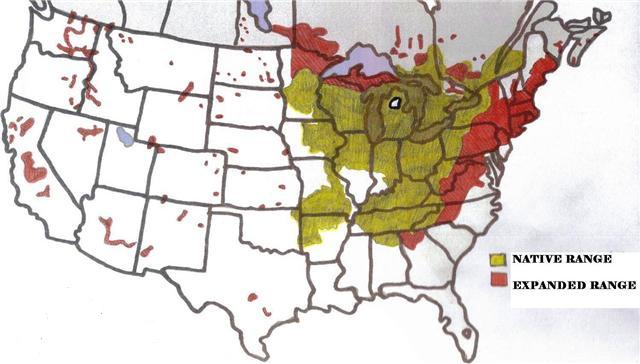
The smallmouth bass generally inhabits streams and rivers with relatively clear water and swift currents, along with many clear-water lakes with gravel or rocky shoreline structure. In regards to its habitat range, there are a number of broad characteristics that these water bodies have in common. The geologic age of a particular water body is perhaps the most important factor in determining what species of fish are present, and in what proportions. All lakes (along with rivers and reservoirs) undergo the natural process of eutrophication, which is normally gradual but can be accelerated by anthropogenic interference. The geological age of a natural lake can be broken down into oligotrophic, mesotrophic, and eutrophic stages. Oligotrophic lakes are the youngest in geological terms: they are usually deeper; full of colder and clearer water; contain high amounts of dissolved oxygen in deep water; very sparse vegetation; and contain rather low nutrient levels. Their shorelines tend to be steeper, rougher, more rock-based, and surrounded mostly by evergreen trees. Consequently, these infertile conditions largely limit the growth of most fish populations. In most of central and eastern Canada, along with the northernmost regions of the Midwest and eastern United States, oligotrophic lakes are most prevalent. In such waters, lake trout tend to be the dominant species.
A lake in the late oligotrophic stage may carry smallmouth bass near shallow water structure, rock basins, or steep drop-offs; meanwhile, more oligophilic species (like lake trout) tend to reign over the deeper, more wide open areas. As eutrophification progresses, conditions slowly arise that make a lake more fertile in terms of bearing a greater number of fish species: water temperatures experience a gradual thermocline; the amount of vegetation increases, especially in shallower areas; nutrient levels, and therefore water turbidity, increase; complex changes result in softer and shallower lake structure, with more gradual shorelines and a basin comprised mostly of gravel and sand. When a lake has reached this middle-aged status, it is deemed mesotrophic, of which walleyes are the prototypical fish species.
Generally, smallmouth bass are most prevalent in lakes which have recently transitioned from oligotrophic to mesotrophic conditions: these adolescent waters offer a surplus of environmental moderation: water is cool rather than cold or warm; dissolved oxygen levels are sufficient enough; vegetation may be present but not overbearing; decent water clarity allows vision to be heavily utilized for predation; and perhaps most importantly, conditions are not as favorable for comparable fish species that prefer strictly oligotrophic (lake trout) or eutrophic (largemouth) habitat. In early mesotrophic lakes, smallmouth bass are able to occupy more numerous and diverse locations; in older mesotrophic lakes, walleye and largemouth bass populations may limit the extent to which smallmouth are free to venture and expand their resources.
As eutrophification proceeds in a late
mesotrophic lake, water temperatures change from cool to warm;
aquatic vegetation becomes very prominent, with heavily-weeded
shallow areas; nutrient levels are relatively high; water
changes from semi-stained to dark and murky; the lake basin is
composed mostly of mud and clay; flattened shorelines often
blend in with the lake’s less-defined outer edges. When
this geologically old lake has maintained such conditions for an
indefinite period of time, it is classified as eutrophic.
Smallmouth bass are virtually nonexistent in eutrophic waters,
which are the most prevalent lake type in nearly all portions of
the United States located south of the Wisconsin border.
Instead,
largemouth bass are usually the dominant eutrophic
lake-dwellers. Eutrophic lakes are generally most
prevalent in all areas of the United States south of Wisconsin.
Eventually, when a lake reaches the dire end of the geological age continuum, it essentially becomes a bowl of soup. The water is too warm, shallow, oxygen-deprived, and overcrowded with vegetation to be considered hospitable for almost any fish species; bullheads and carp are among the only exceptions. While no two lakes are identical, seasonal weather and overall climate changes also affect the location of smallmouth bass within a given body of water, which can vary substantially depending on the time of year. Generally, they occupy shallow water during the springtime spawn, medium depths in the summer, and deepwater drop-offs in the winter.
While they endure a geological aging process that is similar
to that of natural lakes, different portions of the same rivers
and streams may simultaneously exhibit much different geological
conditions. Frankly, this means that rivers and streams
are often home to much more complex and multi-faceted
ecosystems. The environmental conditions that make for
quality smallmouth habitat in a natural lake, which include
water temperature, clarity, depth, and vegetation, broadly apply
to those in rivers as well. Younger segments of a river
are typically those that are deeper, run through rough and rocky
gorges, and are characterized by cold and clear water with a
strong and fast-flowing current; such conditions are most
suitable for trout species. Current velocity is determined
primarily by water level and slope, which can vary from one
location to another just a half-mile downstream.
Middle-aged river segments have more moderate depths and
currents, along with sparse vegetation and a smoother, semi-soft
bottom; walleye and sauger tend to inhabit these areas.
Older river areas tend to be shallower, more vegetated, have
muddier bottoms, and exhibit more laidback currents; these areas
provide a good place for
largemouth bass. Much like
lake-dwelling smallmouth, river smallmouth are best suited for
occupying a transitional space between young and middle-aged
river environments. Interspecies competition amongst fish
is often a lesser issue in rivers, because younger, middle-aged,
and old geological attributes are often present within differing
segments of the same river. Therefore, different species
tend to congregate within those areas that best match their
profile. When considering the complexity of a river, and
its potential to harness an astounding level of ecological
diversity, look no further than the nearby Mississippi River,
which flows along the border between Wisconsin and Minnesota.
Smallmouth, walleye, sauger,
largemouth, and even
catfish are
well-supported and abundant, living happily together within the
same river system, yet unevenly distributed amongst various
segments that best meet their individual habitat needs.

Unlike in lakes, river bass must adaptively cope with the ever-present strains of water current. In general, smallmouth in a river must consume a far greater amount of food than those in lakes or reservoirs in order to compensate for the energy spent swimming though currents. As a result, river bass are comparably stronger and more muscular than the lazy lake-dwellers. As a means of both conserving energy and obtaining a predatory advantage, river smallmouth like to remain close to structural features that create breaks in the current, such as submerged boulders or logs. The slack water found alongside these objects can create practical points from which to ambush and attack unfortunate prey items that may be carried toward the bass via the current.
Along with certain lakes and rivers, some reservoirs have created quality smallmouth habitats as well, although the conditions from which reservoir smallmouth bass benefit are sometimes more artificial than natural. These water bodies are the products of anthropogenic (manmade) impoundment, whereby dam water has been held back for purposes of flooding a terrestrial landscape. Reservoirs with strong smallmouth bass populations are typically derivatives of highland landscapes found in the southern United States, with moderate depths and clear water. In the northern United States, reservoirs of similar construction usually hold walleye. Because they are manmade, reservoirs may hold the greatest potential for bearing dominant smallmouth populations, as conditions can more or less be decided upon to favor against the likes of competing fish species. It is worth noting, however, that the artificiality of such favorable smallmouth conditions might be subject to criticism from an intensely naturalist perspective. Having said that, the largest smallmouth bass ever caught, weighing a world-record 11 lbs. 15 oz., came from Dale Hollow Lake, which is actually a reservoir. Extremely shallow reservoirs filled with lots of weeds or timber are more conducive for largemouth and pike relative to smallmouth, whereas extremely deep reservoirs with underwater canyons and plateaus are too deep and cold to be hospitable for anything more than trout.
Having learned about the various characteristics of lakes, rivers, and reservoirs that provide habitat for smallmouth bass and other fish, perhaps you would like to learn more about how the smallmouth has adapted for success in these environments.
(Return to home page)

